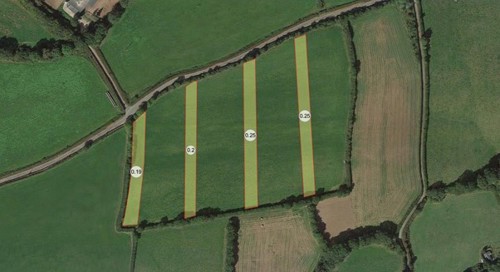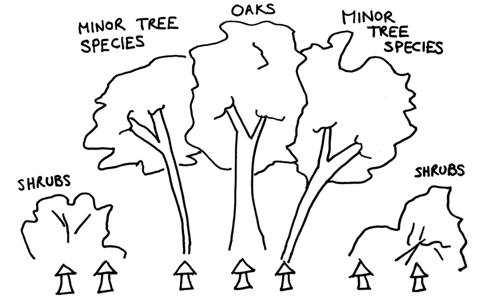What is silvopasture?
Silvopasture is a form of agroforestry where trees are deliberately planted to be part of a farms livestock system. Three tree planting designs are being trialled as part of a field lab investigating the benefits of agroforestry.
Planting trees to suit grazing requirements
Each design has been chosen to suit the grazing requirements of the farmers as well as fitting into the natural environment surrounding the chosen fields. Seven farms across Devon are testing these designs as part of 12 years of farmer led research into agroforestry. The results aim to provide the first ever set of long term data which is practically grounded in the reality of commercial farms. This will give more farmers the confidence to plant trees into their grazing systems.
The designs have been chosen to suit a range of needs so if you are a livestock farmer there is a good chance the principles of one of these designs will suit your needs.
Design agroforestry for your farm
But what do the designs looks like? Why were they chosen? And what benefits are they hoped to bring? Three farmers below have volunteered to share the designs they worked on with the help of The Woodland Trust and FWAG Southwest.
This field lab is also partnered with Rothamsted Research and Organic Research Centre.
Hen Curtis is trialling shelter belts on her farm
Hen has been an organic livestock farmer for 30 years. She needed a design which was compatible with her grazing plan, but which brought in the benefits from the trees in terms of shade, shelter and nutrition.
Hen is part of a 12 year farmer-led research project into silvopasture. Click here to follow how it's progressing.
Environmentally Hen is also keen on increasing soil carbon through sequestration and creating more biodiversity on the farm.
The concept of living barns is to create zones of tree shelter that livestock can choose to access directly on the field. The taller trees in these ‘barns’ naturally reduce exposure to sun, rain and wind and the lower trees and shrubs offer a source of nourishment and nutrition.

The silvopasture design for shelter belts
Hen has chosen a 4 ha field to introduce shelter belts. Because of its position on a hill, the field is exposed to strong winds and her animals are currently without shade and shelter.
Each belt of trees has been planted 12 metres wide in strips across the field. They are oriented north-south to ensure they block the prevailing westerly winds. In the middle of each belt, Hen has planted larger trees like oak, scots pine and aspen. These are planted 3.2 metres apart. At either side of these trees in the belt she has planted faster growing trees like common alder and downy birch. On the outside of the belts she has planted clusters of shrubs including willow, hazel, spindle and elder. Finally, she has planted a mantle of three hawthorn shrubs around each ‘standard’ tree. She expects these thorns to be outcompeted as the trees mature. Overall Hen has planted 20% of the field with a density of 200 trees per hectare.

Why chose the shelter belt agroforestry planting design?
• As the trees mature over the coming decades, the belts will change form as the ‘major broadleaves’ such as oak, scots pine and aspen outcompete the ‘minor broadleaves’ such as alder, cherry and birch. For this reason, the major broadleaves are planted in the centre of the belts where they will be sheltered by the shrubs and minor broadleaves as they grow, before rising and eventually outcompeting the neighbouring trees.
• The hawthorn around each tree will provide a protection for the larger trees, ensuring that the livestock do not damage the trees in early development by rubbing. This should mean the field is taken away from Hen’s grazing system for less time as the livestock can return to graze once the hawthorn is established but the trees are still delicate. This diminishes one of the biggest concerns some farms can have around taking their pasture out of the rotation for so long.
• By grouping the shrubs together there is a higher chance of some surviving if and when they get grazed off by deer and livestock. These clusters also end up as easy access fodder strips for livestock to feed on when they are comfortable in the shade.
The benefits of silvopasture shelter belts
Whilst the farmer loses access to 20% of their pasture through the establishment period, and grass growth will be reduced in the belts over the long term, there are considerable benefits to this system:
• The shelter belts can extend the grazing season as the animals do not have to leave the field for the barn to get the shelter they need in winter. The shelter from the trees also provides a helpful microclimate for the pasture, increasing temperatures early in spring and extending the grazing season by boosting productivity.
• If the field is used for lambing, research shows that shelter belts can substantially reduce lamb mortality as the sheep will be able to use the trees as a living barns reducing their exposure to wind, sun and rain as they lamb.
• The shrubs and smaller trees have varied nutritional benefits for the livestock giving them access to minerals, protein and condensed tannins for self-medication.
• The trees increase biodiversity (with knock on benefits with various ecosystem services), soil health and carbon sequestration on the farm.
Drawbacks of shelter belt design
• As grazing is excluded through the establishment period, BPS payments may be lost in the shelter belt areas.
• Grass growth will be restricted in the shelterbelts.
• There is a potential risk of increased blow fly presence in the belts (although some research suggests this is more than counteracted by the corresponding increase in predators such as bats and birds).
How many trees and shrubs in the shelter belt silvopasture design
| Standard trees (% total) | No. | Shrubs (% total) | No. |
| Downy birch (10%) | 86 | Elder (5%) | 33 |
| Field maple (5%) | 34 | Elm (10%) | 86 |
| Oak (20%) | 171 | Hazel (10%) | 86 |
| Scots Pine (5%) | 33 | Holly (5%) | 34 |
| Alder (5%) | 33 | Spindle (5%) | 34 |
| Aspen (5%) | 34 | Willow (15%) | 113 |
| Hawthorn (seperate) | 1269 |
How much does the shelter belt silvopasture design cost?
| Item | Unit |
| Total area of field (ha.) | 4.23 |
| Area of belts (ha.) | 0.85 |
| No. of trees | 846 |
| No. of thorns | 1269 |
| Fence (meters) | 1163 |
| Cost of trees | £2597.22 |
| Cost of thorns | £761.40 |
| Cost of fence | £5,815.00 |
| Total | £8,412.22 |
Find out more about farmer led research
Follow how the 12 year silvopasture field lab progresses. Or get in touch to discuss your own ideas.
More on silvopasture planting design